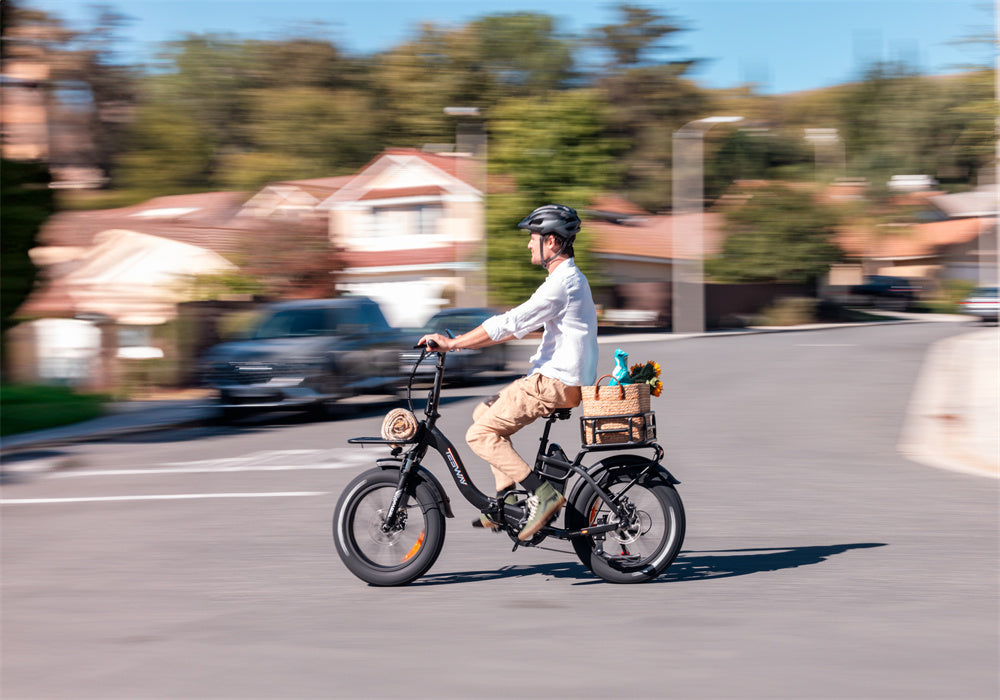Electric bicycle batteries are the powerhouse behind the growing popularity of electric bikes, providing the necessary energy to propel riders farther and faster with less effort. These batteries are integral to the performance and efficiency of e-bikes, dictating how long and how far you can ride on a single charge.
Battery Value Unit
Electric bike batteries are primarily evaluated based on voltage (V), capacity (Ah), and energy (Wh).
Voltage represents the potential electrical energy provided by the battery. Higher voltage batteries can deliver more power to the motor, resulting in better performance. Common ebike battery voltages include 36V, 48V, and 52V. The choice of voltage affects the speed and torque of the e-bike. Higher voltages are typically used in more powerful electric bicycle designed for off-road or high-speed use.
Capacity, measured in ampere-hours (Ah), indicates the amount of charge a battery can hold. A higher capacity battery can store more energy, leading to longer ride times between charges. For instance, a 10Ah battery can deliver 10 amps of current for one hour or 1 amp for 10 hours. The capacity directly affects the range of the ebike, making it a crucial factor for long-distance riders.
Energy, measured in watt-hours (Wh), is the product of voltage and capacity. It provides a more comprehensive measure of a battery’s total energy storage. For example, a 48V 10Ah battery has an energy capacity of 480Wh. This unit helps compare the overall energy storage between different batteries, allowing users to estimate the riding range based on their specific usage patterns.

Different Battery Types
Electric bike batteries come in various types, each with distinct characteristics. The most common types include Lithium-ion (Li-ion), Nickel Metal Hydride (NiMH), Lead Acid, and Lithium Polymer (LiPo).
Lithium-ion (Li-ion) Batteries
Lithium-ion batteries are the most popular choice for electric bikes due to their high energy density, lightweight, and long lifespan. They first emerged in the 1990s and have rapidly become the standard for most portable electronics, including ebikes. Li-ion batteries are widely used because of their efficiency and reliability.
These batteries provide excellent performance, require minimal maintenance, and have a low self-discharge rate. They are capable of hundreds of charge cycles, maintaining a good capacity throughout their lifespan. Most modern electric bicycle come equipped with Li-ion batteries, offering high energy density, lightweight, and long lifespan, typically lasting between 500 to 1,000 charge cycles.
Nickel Metal Hydride (NiMH) Batteries
NiMH batteries were widely used in the early days of electric bikes and other electric vehicles but have largely been replaced by Li-ion batteries due to the latter’s superior performance characteristics. NiMH batteries offer decent energy density and are more environmentally friendly than lead acid batteries.
However, they are heavier and have a higher self-discharge rate, meaning they lose charge faster when not in use. NiMH batteries also tend to have a shorter lifespan compared to Li-ion batteries, making them less cost-effective over time. Today, they are less common in ebikes but still used in some applications where cost is a critical factor.
Lead Acid Batteries
Lead acid batteries are the oldest type of rechargeable battery, dating back to the 19th century. They are the most affordable and durable type of electric bike battery. Despite their low cost, they are also the heaviest and least efficient option. Lead acid batteries are capable of delivering high current, making them suitable for applications requiring significant power output.
However, their weight and bulkiness make them less desirable for electric bicycle. Due to their weight and shorter lifespan, they are less common in modern e-bikes. Key characteristics include low cost and durability, being able to withstand rough handling and deep discharges. They are mostly found in budget bike or older models, and their usage in new bike motorized designs is declining.
Lithium Polymer (LiPo) Batteries
Lithium Polymer batteries are a variation of lithium-ion technology but are housed in a flexible, polymer casing instead of a rigid metal case. This makes them lighter and more adaptable to various shapes and sizes. LiPo batteries offer high energy density and a lightweight profile.
They emerged in the early 2000s and have been used in applications where weight and form factor are crucial, such as drones and some high-performance e-bikes. However, they require careful handling due to their sensitivity to physical damage and potential safety risks. LiPo batteries also have a shorter lifespan compared to traditional Li-ion batteries, often requiring more frequent replacements.
Solid State Batteries
Solid-state batteries are an emerging technology that promises to revolutionize the battery industry. These batteries use a solid electrolyte instead of the liquid or gel found in traditional batteries. This design offers higher energy density, faster charging times, and improved safety. Solid-state batteries are still in the development stage and are not widely used in ebikes yet, but they hold significant potential for the future.
Nickel-Cadmium (NiCd) Batteries
Nickel-Cadmium batteries were among the first rechargeable batteries used in portable electronics. They have a high discharge rate and can deliver significant power. However, they suffer from the "memory effect," where their capacity diminishes if not fully discharged before recharging. NiCd batteries are also less environmentally friendly due to the toxic cadmium they contain. While they have been largely replaced by NiMH and Li-ion batteries in most applications, they are still used in some niche markets.
Aluminum-Air Batteries
Aluminum-air batteries generate electricity through the reaction of aluminum with oxygen in the air. They have a high energy density and can provide a much longer range than traditional batteries. However, they are not rechargeable in the conventional sense and need to be replaced after their chemical reaction is exhausted. This makes them less practical for everyday use but potentially useful for specific long-range applications.

What Size Battery is Best for an Electric Bike
For high-speed rides or frequent acceleration, a higher voltage battery such as 48V or 52V is ideal as it can deliver more power to the motor. For leisurely rides at moderate speeds, a 36V battery might suffice.
For long-distance rides, a battery with higher capacity like 15Ah or 20Ah is crucial. Higher capacity batteries store more energy, allowing you to travel further between charges. Hilly or rugged terrains demand more power from the motor.
In such cases, a combination of high voltage and high capacity, such as 48V 15Ah, ensures your e-bike performs well without running out of power quickly.
Battery Sizing Examples
An urban commuter might find a 36V 10Ah battery suitable for short, flat city commutes, offering a balance between weight and range. Long-distance riders may benefit from a 48V 15Ah battery, providing ample energy for extended rides. Off-road enthusiasts might require a 52V 20Ah battery, offering the power and capacity needed for challenging off-road trails.

Can You Install a 52V Battery on a 48V E-Bike?
No, you cannot safely install a 52V battery on a 48V e-bike. While a 52V battery can technically fit and power the motor, it is not recommended due to compatibility issues. E-bike systems are designed with specific voltage ratings to ensure optimal performance and safety. Using a higher voltage battery than the system is designed for can lead to overheating, damage to the motor and controller, and potential safety hazards. Upgrading components to support higher voltage can be complex and may not be worth the risk and expense.

Charging Best Practices
To maximize the lifespan of your e-bike battery, follow these charging best practices:
Always use the charger provided by the manufacturer or a compatible charger that meets the specifications of your battery. Using an incompatible charger can damage the battery and reduce its lifespan.
Charge your battery in a cool, dry place. Extreme temperatures, both hot and cold, can negatively affect the battery’s performance and longevity. Ideally, charge your battery in a room temperature environment.
Modern e-bike batteries come with built-in protection to prevent overcharging. However, it’s still good practice to unplug the charger once the battery is fully charged to avoid unnecessary stress on the battery.
Lithium-ion batteries do not suffer from the memory effect, so it’s perfectly fine to charge them partially. Frequent partial charges can be better than deep discharges, which can strain the battery.
Try not to let your battery run completely empty. Deep discharges can stress the battery and shorten its lifespan. It’s best to recharge the battery when it reaches around 20-30% capacity.
Conclusion
E-bike batteries are a crucial component that significantly impacts the performance, range, and overall experience of riding an electric bicycle. You can buy ebikes with the best batteries at TESWAY!
FAQs
What are the most common types of batteries used in electric bikes?
The most common types of batteries used in electric bikes are Lithium-ion (Li-ion), Nickel Metal Hydride (NiMH), Lead Acid, and Lithium Polymer (LiPo) batteries.
How does battery voltage affect an electric bike’s performance?
Higher voltage batteries can deliver more power to the motor, resulting in better performance, faster acceleration, and higher top speeds.
What should I consider when choosing a battery size for my electric bike?
When choosing a battery size, consider your riding style, the distance you typically travel, and the terrain. Higher capacity batteries are better for long-distance rides, while higher voltage batteries offer more power for hilly terrains and faster rides.







Share:
Bicycles have weight limits but heavyweight riders can still find the perfect bike
Traditional-Electric: The Historical Evolution of Road Bikes